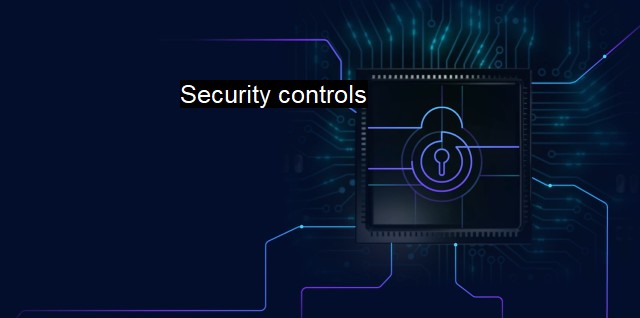What are Security controls?
Shielding Digital Infrastructure: The Vital Role of Security Controls in Cybersecurity
Security controls is a broad term referring to the management, operational, and technical processes and measures used in cybersecurity defense to safeguard its technical infrastructure and the data it houses. There are different types of security controls to consider from access restrictions, firewalls, antivirus and anti-malware software, network monitoring systems and virtual private networks.Security controls exist for a clear reason: to meet crucial cybersecurity protection objectives. These objectives focus primarily on three areas: confidentiality, integrity, and availability (commonly known as the CIA Triad). Confidentiality looks at safeguarding sensitive information from unauthorized individuals.
Security controls protect the integrity factor by safeguarding the information's accuracy and reliability, preventing its alteration or destruction either accidentally or intentionally. They ensure the information's availability for authorized individuals whenever they need it, guarding it against intentional or unintentional interruptions or denial of access.
Technical security controls are established within the system's hardware and software. These controls can be detective such as intrusion detection systems to monitor potentially malicious activity on the network or preventive like firewalls and encryption processes. These set controls will swiftly detect malware or trojan software and quarantine and eliminate any located threats, thus maintaining the overall system's integrity.
Operational security controls are established to manage the overall use of resources inside an organization. They include developed procedures and responsibilities, such as user training and awareness programs, management supervision, procedures to follow when software is developed or changed, and emergency or contingency planning. There is an emphasis on people and processes to implement these controls successfully. Often, the human factor can be the weakest link in any cybersecurity strategy, but through well-structured operational security controls, it can be minimized.
Management security controls, on the other hand, are strategic and guide the operational and technical controls. They include conducting risk assessments, developing strategies to manage those risks, security planning, and defining responsibilities and power limitations. While technical and operational controls focus on solving identified issues and threats, management security controls try to anticipate future challenges and manage the identified risks.
An essential management security control in the field of antivirus is ensuring that the antivirus software remains up-to-date with the current viruses, trojans, and malware and the latest tactics employed by hackers. Regular virus database updating is critical to maintaining security and adequately protecting against the evolving and growing number of threats every day.
Another type of antivirus security involves developing redundancy in antivirus software and systems. This redundancy would have layers of antivirus and anti-malware software to guard any potential infiltration from different types of cyber-attacks.
To sum up, security controls are indispensable against cyber threats. Paralleled with human initiatives, sensitivity, awareness, they form a formidable defense against any potential breaches. Implementing security controls is more than just a reluctant requirement; it is an integral part of guaranteed digital security protection. While these controls are not invulnerable, they significantly curtail the risk of a devastating cyberattack, making organizations less tempting and more challenging targets to hackers, thereby fortifying an organization’s cybersecurity stance.

Security controls FAQs
What are security controls?
Security controls refer to the measures and strategies put in place to protect an organization's information systems and data from unauthorized access, modification, disclosure, or destruction. They include the use of antivirus software, firewalls, access controls, encryption, and intrusion detection systems.Why are security controls necessary for cybersecurity?
Security controls are necessary for cybersecurity because they enable organizations to detect, prevent, or mitigate security threats and attacks. By implementing security controls, organizations can reduce the risks associated with cyber threats, such as malware infections, hacking, and data breaches.What types of security controls are used for antivirus protection?
There are several types of security controls used for antivirus protection, including real-time scanning, behavior monitoring, signature-based detection, and heuristics analysis. Real-time scanning ensures that files are scanned as they are accessed or downloaded, while behavior monitoring checks for suspicious activities that may indicate malware infection. Signature-based detection involves comparing new files with a database of known malware signatures, while heuristics analysis uses algorithms to detect unknown threats based on their behavior.How can organizations ensure that their security controls are effective?
Organizations can ensure that their security controls are effective by regularly testing them through penetration testing, vulnerability scanning, and security audits. These tests help identify weaknesses or vulnerabilities in the security controls and enable organizations to take corrective action to improve their security posture. Additionally, organizations must keep their security controls up to date by regularly patching software vulnerabilities and installing the latest antivirus updates.| | A | | | B | | | C | | | D | | | E | | | F | | | G | | | H | | | I | | | J | | | K | | | L | | | M | |
| | N | | | O | | | P | | | Q | | | R | | | S | | | T | | | U | | | V | | | W | | | X | | | Y | | | Z | |
| | 1 | | | 2 | | | 3 | | | 4 | | | 7 | | | 8 | | |||||||